History of Fashion 1940s – 1950s
History of Fashion 1940s – 1950s
“As long as there is a desire for change and sense of fantasy – there will be fashion.”
Vogue 1940
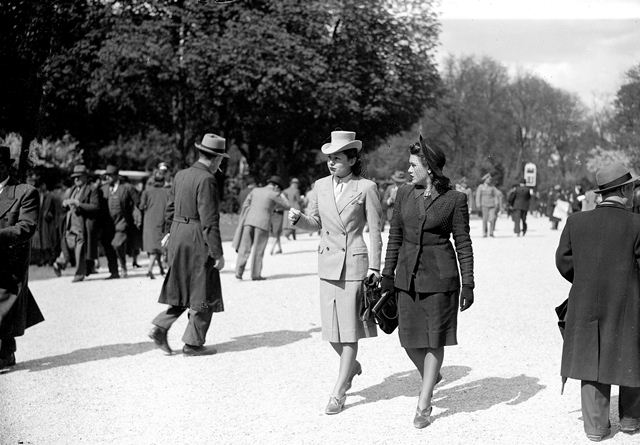
Copyright © AFP / Lapi / Roger-Viollet
The Forties
With the start of World War II life changed for the world. Women were required to make a contribution to the war effort and with women working, a huge impact happened to fashion. After decades of freedom and opulence, economic constraints and a feeling of social responsibility hit the fashion world creating a new utility and austerity: women were in uniform.
Art and Culture
A positive music style was formed during the early Forties. The ‘Big Band’ music style created an encouraging distraction form the war. Famous musicians of the time included Benny Goodman and Count Basie. The 1940s style influenced the rock and roll style of the Fifties.
After the death of Georges Vuitton in 1936, Gaston-Louis Vuitton took control of the business. During the German occupation of France, Louis Vuitton collaborated with the French Vichy regime, Philippe Petain and the Nazis who were responsible for the exile of French Jews to German concentration camps. Louis Vuitton started a factory whose only purpose was to produce products glorifying Petain and his government regime which led to an increase in income for the company.
Helmut Newton was an Australian/German fashion photographer known for his black and white photography. During the forties he became a customary for Vogue and other publications including Jardin des Modes, Elle, Queen, and Marie-Claire.
Rationing
Rationing was introduced to ensure a fair allowance was given to British citizens. With rationing on food, clothes and footwear, it forced women to wear what they already had in their wardrobes. In 1942 the British government introduced a law under the Civilian Clothing Order, which made it illegal and unpatriotic for some manufactures to spend time embellishing clothes for sale. This made using extra stitching, pleats, pockets, buttons and extravagant trimmings illegal, dramatically changing fashion, encouraging the utility style.
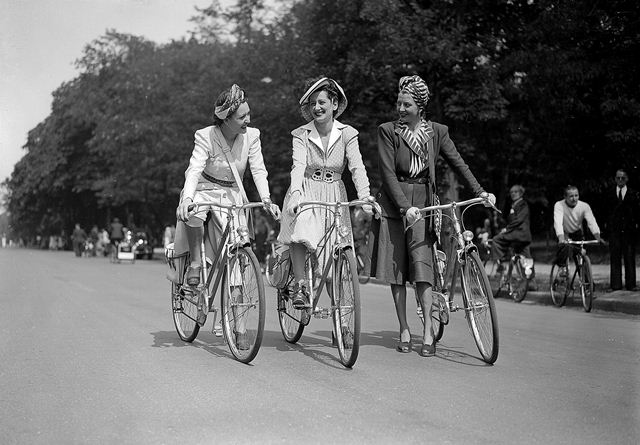
Copyright © AFP / Lapi / Roger-Viollet
Shapes and Silhouettes
As rationing hit full force, alternative cheaper dresses were created. The idea of function became prominent. A simple, understated shape was seen with the use of simple fabric.
As transport changed, more people used bicycles, leading to skirts becoming shorter and less restricted. Suits became a popular item for women during this era. The look became so prevalent it was even seen as acceptable for brides. The Utility look formed due to the need for practical, professional wear for women while working. Sensible flat heeled shoes were worn with square shouldered jackets that resembled the cut of uniforms.
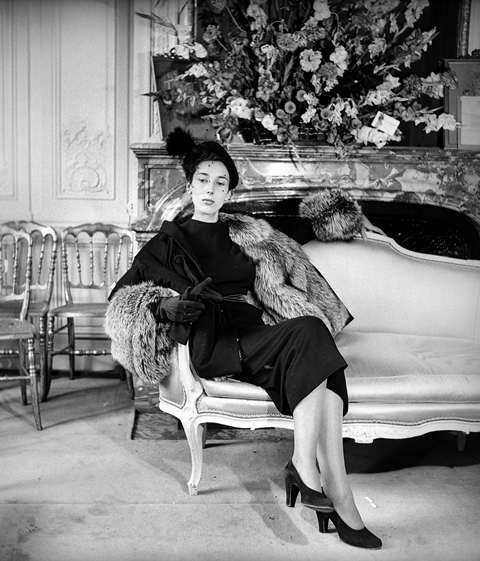
Copyright © AFP / Lipnitzki / Roger-Viollet
Dior’s New Look
With the end of the war, women wanted to get away from the war austerity and utility clothing. After the rationing of fabric, Christian Dior wanted to use an excess of material and his sumptuous use of fabrics was a bold choice. The New Look in the summer 1947 emphasized the bust, waist and hips reasserting female sexuality. The style had fuller skirts with crinoline used with petticoats and netting. The garments moved with ease and were worn with bustiers. The shaped fitted jacket designed to go with the full skirt was also worn with a straight mid calf length skirt.
Accessories
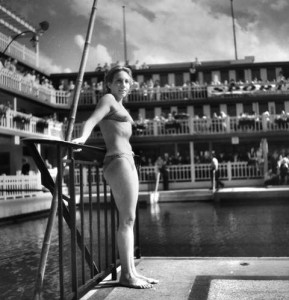
Copyright © AFP / Lipnitzki / Roger-Viollet
In opposition to the utility styles the modern bikini was introduced in the forties by fashion designer Jacques Heim and engineer Louis Reard in Paris. The new swim wear consisted of two pieces and in May 1946 was advertised as the worlds ‘smallest bathing suit’. Reard named the new swimsuit ‘bikini’ taken from the Bikini Atoll island where testing on atomic bombs was taking place. It is thought that Reard believed the provocative and revealing style would create similar shock reactions from those created by America’s atomic bomb in Japan from the previous summer. Reard adapted the style by making the bottoms smaller creating a string bikini. They found it hard to find model to wear the design and were forced to hire a nude dancer to model the creations.
Mannish shoes started appearing to meet the need for practicality leading to brogues becoming popular for women. Turbans became a useful accessory for women to be used as a safety device for working in factories they also doubled as a means to hide the unkempt untidy hair of women running a household and working at the same time.
Make, Do and Mend
With rationing in place the government encouraged a motto of ‘make, do and mend’. Restyling and remaking what was in your wardrobe was essential. Women that could sew would create new items out of anything; blankets, coats and pillowcases were all cut and reworked into a new garment.
With stockings being scarce, women would draw down the back of their legs with eyeliner to create the look of seams in tights. Knitting was also encouraged for women; patterns were given away for free so women could knit for the troops, supporting the idea that everyone can do their part.
Menswear
Taken from the inspiration of the Big Bands, Zoot suits were worn. A wider legged trouser with a high waist was worn with a longer jacket. Knitwear was also popular with bold brighter prints on men’s jumpers.
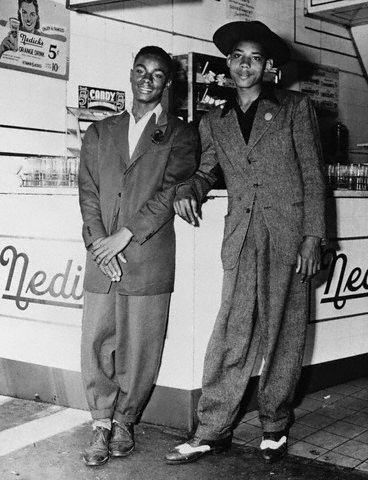
zoot Fashion 1943
The Icons
The early icons of the forties had a simple and plain look. Betty Davis was an icon who was known for her portrayal of unsympathetic characters. She was one of the forties most celebrated actresses known for her forceful style. Rita Hayworth also came to prominence during the forties with films including “Cover Girl” and “Gilda”. Her appeal made her a popular sex symbol and pin up girl.
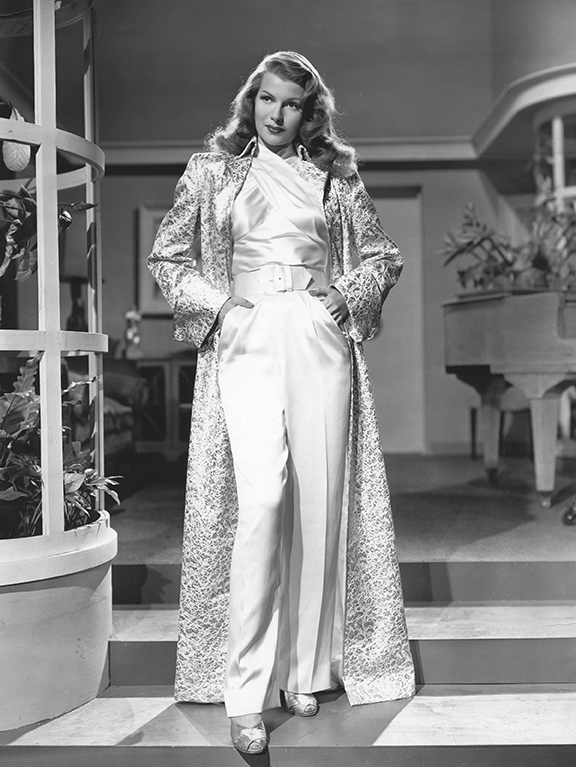
Copyright © AFP / Columbia / The Kobal Collection – Rita Hayworth
The Designers
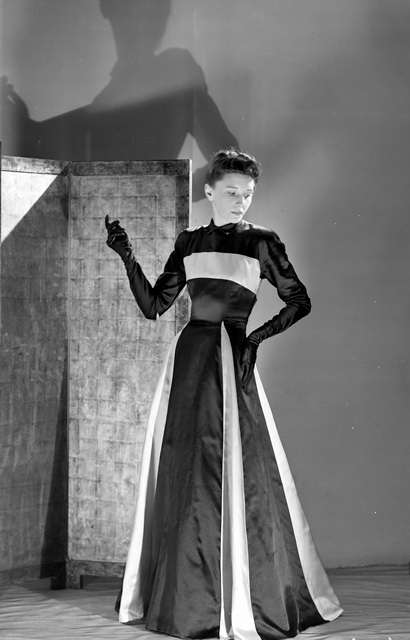
Copyright © AFP / Albin-Guillot / Roger-Viollet – Balenciaga 1940
Claire McCardell is a hugely important fashion designer of the 20th Century. She is credited for helping to create ‘The American Look’. She created a comfortable, practical look and pioneered the American style of casual sportswear. She once stated, “I belong to a mass production country where any of us, all of us, deserve the right to good fashion”. Inspired by active wear and menswear, she used minimal fabric and was dedicated to the democratization of fashion.
Charles James was seen as America’s first couturier. Known for his highly aesthetic structures, his clothes were looked upon as works of art. From 1942 to 1945 he collaborated with Elizabeth Arden showing his couture designs in her salon. His most successful collection was shown in 1947 in Paris. Christobal Balenciaga called Charles James “the world’s best and only dressmaker who has raised (dressmaking) from an applied art to a pure art form.”
As an immigrant in London, Guccio Gucci worked in the Savoy Hotel as a maitre. Impressed by his guests sophisticated and luxurious luggage he developed an interest in luggage. On returning to Florence, Gucci established a shop in 1920 selling fine leather goods with classic styling.
Gaining a reputation for quality, he had hired expert workmen and in 1938 expanded his business to Rome, opening the company’s first retail shop. During the forties he created the iconic Gucci symbol of the interlocking G’s that is still identifiable and used today.
History of Fashion 1940s – 1950s


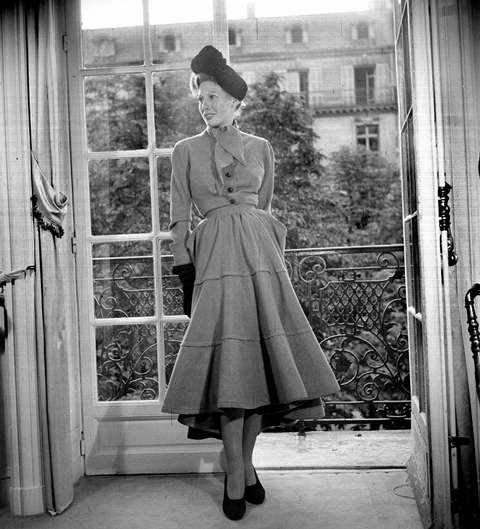
I am currently working on a blog about wedding gown fashion and am referencing the clothing styles of the 1940s and 1950s. I’m so happy to find your blog. Very informative and great photos!
Finally, some actual information on designers in the 40’s! I think you just saved me from failing my exam tomorrow. Thank you very much, my case study is now complete. And, beautiful photographs. E x
What were the first dates that clothing was sold on-line-via computers?
(Nice site, by the way!)
hi.
It was in the 2000’s with the Natalie Massenet founder of Net-a-porter.
Regards
i wonder how people could wear those kind of clothes back then ya they look conformable but some of them look ugly…
Ya, well at least they probably look better than your clothes.
hello, i am doing a school project on 1950s fashion and was wondering -how did the prior existing situation before change the 1950s fashion? Pretty much how did 1940s fashion influence/change the 1950s. Thank you!!!!!!!!
very helpful and informative article. thankyou!
I LOVE this article…. I’m of the firm belief that in my former life I was a 1940s night club doll….
I am of firm belief that I was a dyed-in the wool 1940’s war worker by day, night club doll at night.. You know Sardi’s, the Cafe Rouge, Ciro’s, the Hotel Astor, et al
This article made my heart skip a beat and sigh at the same time……
Accept my congratulations on the article….. Tis a job well done and made this woman dream again…… 🙂
Im currently studying fashion and textiles and i have a test in a couple of hours but this has been so helpful and informative thanx a mil 🙂
I have a picture of my grandmother at the age of 15 wearing what looks to be a white 3/4 sleeve dress with deer or fawns on it. My grandmother died in her young mid 20’s leaving behind 12 children and now around 80 grandchildren. We have only a handful of Picts. Please help me find the history of the dress. I have an original picture.
Where were some important places where fashion was popular?
From my mother’s belongings I found a beautiful wool suit with the lable Helen Galin Ltd. Do you have any information about Helen Halin?
Good history and insights